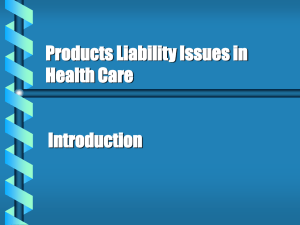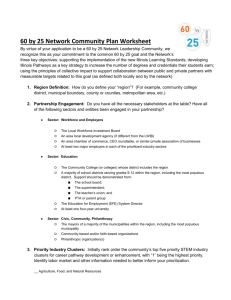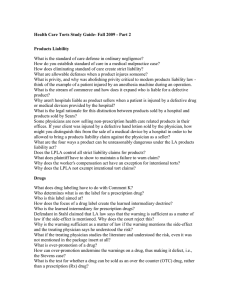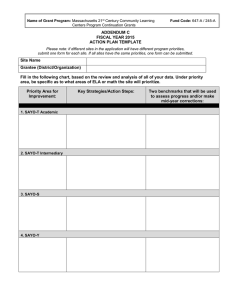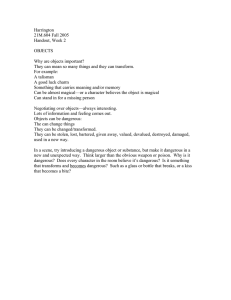Drug Liability From Learned Intermediary to Twitter
advertisement
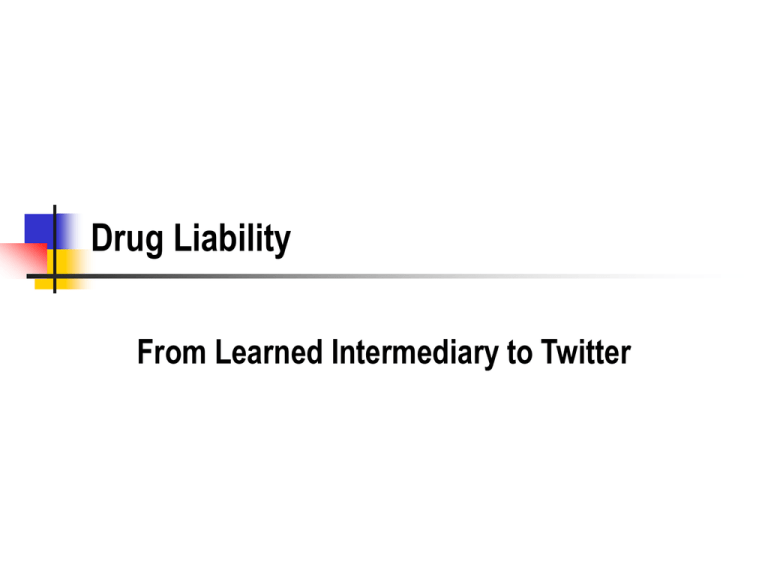
Drug Liability From Learned Intermediary to Twitter Restatement of Torts 402a (1) One who sells any product in a defective condition unreasonably dangerous to the user or consumer or to his property is subject to liability for physical harm thereby caused to the ultimate user or consumer, or to his property, if (a) the seller is engaged in the business of selling such a product, and (b) it is expected to and does reach the user or consumer without substantial change in the condition in which it is sold. 2 Limited Defenses under 402a (2) The rule stated in Subsection (1) applies although (a) the seller has exercised all possible care in the preparation and sale of his product, and (b) the user or consumer has not bought the product from or entered into any contractual relation with the seller. 3 Comment I - Dangerous Products Products That Are Dangerous As Used Good Whiskey Good Tobacco Are There Unexpected Risks? Fetal Alcohol Syndrome Premature Babies Were There Misrepresentation? Tobacco Additives Claims that Smoking Is Not Addictive 4 Comment K Unavoidably Unsafe Products Key Defense for Drugs Recognizes that Many Drugs are Very Dangerous Old Pasteur Rabies Vaccine Example Looks at the Label Information Does it Explain How to Use the Drug? Does it Warn about Dangers? Did it Get to the Decision-maker? 5 Who Else is Liable? Usually Both Sellers and Manufacturers Are Liable Health Care is Different Product v. Service Distinction The Patient is Not the Buyer The Doctor is Not the Seller The Hospital is Not (Considered) a Supplier Limited Liability for Pharmacies 6 What is the Implications of Health Care Providers not Being Liable? What is the incentive of a seller who can be liable for product defects? If you are a plaintiff's attorney, why do you go after the drug manufacturer? Why is the even more important in Louisiana? 7 Product Must Be Defective Manufacturing Defect Easy to Prove Limited Number Affected Example: Improper Sterilization Design Defect Effects Every Unit Thalidomide, DES, Mer-29 Vioxx 8 Prescription Drug Liability History of the Medicine: Drug Law Step back in time, when the laws were formulated Rx drugs were only advertised to physicians Informed consent was not yet an accepted duty Medical care was paternalistic Rx drugs were not blockbusters and only a small part of a small health care budget Relatively few effective drugs 10 Drug Labels and Comment K Modern drug law is products liability The very nature of an Rx drug means that it cannot be safely used by a consumer Comment K tells us that you can only cure dangerous drugs with warning If the consumer cannot understand the warning and criteria for the using the drug safely, who can? 11 The Label as Part of the Product If a drug cannot be safely used without a proper label, then an inadequate label is a product defect An effective drug label must have: Indications for use Information about effectiveness Contraindications for use Complications Interactions with other drugs 12 How do We Judge the Adequacy of a Label? Consumer products Reasonable consumer Foreseeable use Foreseeable misuse Technical Products Skilled user We depend on limits in the distribution chain to keep these products out of the hands of laypersons. Think blasting caps 13 The Learned Intermediary Rx drug labels are written for physicians Rx drugs can only be obtained with a prescription The courts created the learned intermediary doctrine The adequacy of the label is judged by a reasonable physician standard 14 Implications of the Learned Intermediary If the doc is given adequate information, but still used the drug incorrectly, it is medical malpractice, but the manufacturer is no liable. There is no duty for the manufacturer to communicate information to the patient, absent a PPI requirement It is the physician who decides whether the benefits of the drug outweigh the risks, not the patient Who is really the consumer of drugs in this classical model? 15 Attacking a Label The core attack on a label is that it does not include a risk, so there can be no waiver of the risk DES - no warning of cervical cancer Vioxx - no warning of heart attack risk A collateral attack is that the manufacturer lied to the FDA about the benefits and that the drug should not have been approved, and is thus too dangerous Psychiatric drugs for kids 16 Who is a Learned Intermediary? Reyes v. Wyeth Laboratories, 498 F.2d 1264 (5th Cir. 1974) Polio vaccinations Administered by a nurse Individualized evaluation by a physician? Is the nurse a learned intermediary? Solved with standard form consents Why have consent for mandatory vaccinations? 17 Dilution of Warnings - Over Promotion Stevens v. Parke, Davis & Co., 507 P.2d 653 (Cal. 1973) Chloromycetin (chloramphenicol) Valuable antibiotic Dangerous side effects, should only be used as a last resort Widely promoted as a general use drug Most common sin in the drug business 18 Perez v. Wyeth Laboratories Inc., 161 N.J. 1, 734 A.2d 1245 (N.J. 1999) Norplant Heavily promoted directly to women Plaintiff sue, claiming the label was defective because it denied them info Is this a learned intermediary case? 19 Direct to Consumer Marketing Why are contraceptives special? How has the physician patient relationship changed? First, with rare and wonderful exceptions, the "`Norman Rockwell' image of the family doctor no longer exists." The court found a duty to the consumer when it can be shown that the doctor cannot be counted on to exercise judgment 20 The Autism Cases and the Vaccine Injury Compensation Fund Stahl - Next time 22 23
